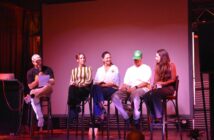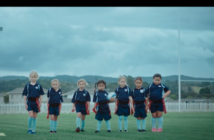Read part two of More than one Model in the Sea here.
Variety is the spice of life
While seeing ex-agency staff in marketing departments is nothing new, Leighton Howl, talent director at recruitment agency The Pond, looks back at the GFC as a point where things changed. When it struck, agencies were forced to downsize and Howl says the talent market was flooded with account directors and senior management who took a pay rise to cross over and make a new home for themselves in client organisations.
“They are good strategists and good marketers – maybe better than traditional marketers,” says Howl.
But it’s not for everyone and, generally, for design directors, creative directors and art directors, Howl says the goal is to be at an agency working on a variety of clients and doing a variety of creative work.
DDB’s Stapleton is one of those creatives, and having worked on the Football World Cup in South Africa, car accounts, FMCG brands and banks, he knows how the variety gives creatives different ways of looking at problems.
“I know there are a lot of American agencies with creatives that have only worked on one account and I know it kills them.”
For many, the appeal of an agency environment is about being in a creative culture, being stretched, dealing with the stress of client demands and delivering the goods. And while in-housing sounds good in theory, Stapleton says creating great work and maintaining a creative culture is very difficult in practice.
“I don’t know if everyone understands how to make a creative department. They see it as capability but building a creative department is hard.”
Looking at his own department, he talks about hiring a diversity of thought because “if you have enough strange people in a room you will get somewhere interesting”.
He says it’s a constant experiment in the department but will deliver better outcomes than putting a lot of the same people in a room.
Another creative with a need for variety of work to sink his teeth into is Mark Easterbrook. Working on both sides of the industry as a freelance writer and creative director with Easterbrook Words & Ideas, and a contract copywriter for Les Mills International, he says he couldn’t commit to a full-time job on client-side because he enjoys the variety.

For other creatives, particularly those who have been around for a long time, he says to make the jump to client- side will require a certain degree of account service skills because in-house you have to have direct conversations, take feedback directly and do things an agency suit would.
“For some creatives, their worst nightmare is having to talk to the client everyday face- to-face. They would hate it,” he says. “Whereas I was always the person screwing up my face to the suit saying ‘can we just talk to them directly please? I don’t understand the feedback now it’s come through four people’.”
But when asked if creative talent coming into the industry now would see in-house as an option, he thinks yes.
For the younger people coming through it’s a perfectly viable option that might not have been there 10 years ago, he says.
And it might become a need, as Easterbrook sees the potential for there to be fewer agencies further down the track if in-housing continues.
Howl agrees. When looking at the future, he doesn’t see the “fat agencies that do everything”. They will be slimmed-down he says, to produce high-end, game-changing, more specialised work in a tighter, leaner and faster way.
And as agencies shed some weight, marketing teams will grow and make a home for the day-to-day commoditised work.
“It will be a 50:50 marketplace,” he predicts.
And for those organisations that do in-house, The Warehouse Group’s Berglund would like to see the work to not be talked about as a product of in-housing.
Like Stapleton suggests not getting hung up on labels, Berglund wants the reaction to the work to be the same.
“I would like to get to the point where in-house and out-house is not a conversation,” he says. “It’s just about the creative and not looked at as ‘oh it’s by an in-house, that’s a surprise’.”
“Because we can do it, without a doubt.”

On the MoveTalent is always on the move. And while agency folk are increasingly moving to the relative safety of client side, there are other suitors, namely the tech juggernauts and consultancies, which are both upping their creative game to try and snatch business away from ‘traditional’ agencies. The rise of the tech platforms have in some way facilitated the increasing in-house resource among clients as brands can communicate directly with consumers through many of these channels. And, just as media companies like TVNZ, Bauer and NZME have set up their own creative studios, so too have the tech companies. In 2017 Special Group Australia’s founding creative partners Matty Burton and Dave Bowman left the agency to take over the Google Zoo operation across the Asia Pacific region, following Tor Myhren who crossed the floor from his role as president and chief creative officer at Grey to become vice president of marketing and communications at Apple at the end of 2015. Another international player making the move that year was Lars Bastholm who went from chief creative officer of Cheil USA to global chief creative officer of Google’s The Zoo. The following year it was Andrew Keller, former Crispin Porter + Bogusky CEO who joined Facebook as the global creative director for in-house creative team Creative Shop. His move saw Keller report to Creative Shop chief creative officer Mark D’Arcy, a former Time Warner ad executive (and New Zealander) who joined the social media giant in 2011. Local creatives Tara McKenty and Iain Nealie were snapped up by Google as creative directors for the APAC region about four years ago after showing promise at WhybinTBWA and Saatchi & Saatchi, and Contagion’s Tom Bates went to work for Snapchat in 2017. Having largely stolen the strategic work of agencies and doubling down on digital transformation, the large consultancies are also expanding into the communications sector. This has been more obvious in the Australian market, where the big four have made a number of agency acquisitions and hired big names from the media, marketing and agency sector – like adland personality Russel Howcroft moving to PwC as chief creative officer, or Droga5 boss Sudeep Gohil joining KPMG as head of brand strategy, or a big chunk of McCann Melbourne joining Deloitte. Accenture’s Ben Morgan says the changing needs of brands has demanded a new model that sees consultancy, creative and technology converging – bringing together brand strategy, design, communications, customer experience and product development at scale. “Accenture’s acquisition of creative agencies such as Karmarama and The Monkeys are driven by the need of this new, modern CMO, and it is proving a real differentiator. The ability to forge customer experience end-to-end better reflects the modern adland, which the traditional agency cannot cater for.” |




